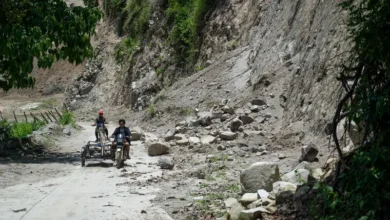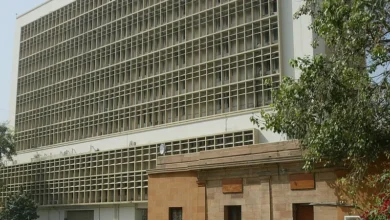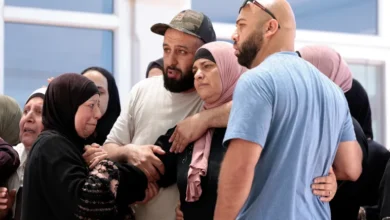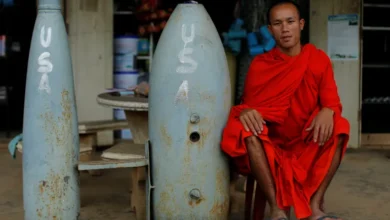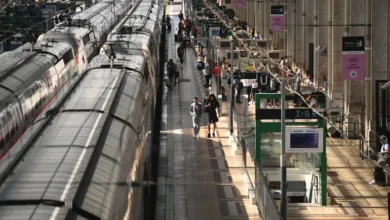Survivors wait ‘in hell’ after Cyclone Mocha pummels Myanmar

On Saturday, as “extremely severe” Cyclone Mocha gathered speed in the Indian Ocean and tracked a straight course for Myanmar’s northwestern Rakhine coast, Hla Tun made a critical decision.
While the vast majority of the residents of the seaside city of Sittwe, including his wife and daughter, headed inland or to higher ground, he instead taped up his windows, stocked up on food, and braced for the cyclone along with 11 neighbours who had taken shelter in his home.“If I stay here, maybe I can save some people if the flooding or something serious happens,” he told Al Jazeera to explain his decision.
Less than 5 kilometres (3 miles) away, in a camp where ethnic Rohingya have been confined since fleeing clashes with the state’s majority Rakhine population in 2012, Si Thu also considered his options.
His low-lying camp, overcrowded with bamboo shelters, was unlikely to withstand heavy wind and flooding, so he and his family decided to go and stay with relatives in a nearby Rohingya village of Thae Chaung.
The next day at about noon, Cyclone Mocha swept across the Rakhine coast with wind speeds of up to 250kmph (155mph). Five hours later, it had left what the United Nations described as a “trail of devastation” in its wake, particularly in Sittwe.
“It is like a broken city,” said Hla Tun, who estimated that 95 percent of the houses in the Rakhine state capital had been damaged.
Setting out on his motorbike for the town of Kyauktaw, 100km (62 miles) inland, to find his family, he encountered collapsed bridges, destroyed farms and homes, and the body of a drowned Rohingya woman washed up in a pile of mud and debris.
He worried not only about the immediate days ahead but about how communities would survive the coming year.
“Many vulnerable households will not be able to build their houses again,” he said. “This is the farming season, but it is gone.”From the Rohingya camp of Thet Kae Pyin, Si Thu told Al Jazeera that about 95 percent of the shelters had been obliterated and that at least 400 Rohingya were believed to have lost their lives.
Survivors, he said, were now facing a dramatic increase in the price of food and basic goods, as well as urgent medical and sanitation needs.
“A lot of people were hit by different kinds of materials,” he said. “Many people have died, but there is no one to clean it, and almost every toilet in the camp was totally destroyed.”Hla Tun and Si Thu are using pseudonyms given the risk in Myanmar of speaking to the media.
While the full extent of the cyclone’s damage is still being assessed, initial reports indicate that it was the worst natural disaster to hit Myanmar since Cyclone Nargis in 2008. The UN reported that nearly 3.2 million people were likely to have humanitarian needs as a result of the storm, which in addition to Rakhine state, severely damaged homes, infrastructure and farms in parts of Chin state, Magway and Sagaing regions.
Many people in the affected regions live in areas with an active presence of armed groups who are opposed to the military, which seized power in a February 2021 coup and has since blocked humanitarian aid to areas harbouring armed resistance, according to numerous human rights and media reports.
Even in places controlled by the military administration, including Sittwe, relief access remains uncertain. As of Thursday, humanitarian responders, including UN agencies and international aid groups, were still waiting for the military’s permission for them to go into six townships identified as the worst affected in Rakhine state or to begin distributing emergency supplies.
Many now fear a repeat of 2008, when Cyclone Nargis devastated the country’s Ayeyarwady Delta and more than 130,000 people died amid what Human Rights Watch described as the “brutal indifference of Burma’s military government to the welfare of its people”, using the old name of Myanmar.
“This is the most challenging time in my life,” said a Rakhine humanitarian worker with more than a decade of experience in the international aid sector speaking on the condition of anonymity due to concern about repercussions from his employer. “We have a lot of issues … a natural disaster [in areas affected by] armed conflict, intercommunal conflict … and where international communities are struggling to do their work effectively. We are in hell.”
‘Pushed to the brink’
Twelve interviews conducted for this report indicate massive community needs as well as significant obstacles to the response in areas racked by war and underdevelopment. In hard-hit Rakhine, the situation appears to be particularly fraught.
The people of Rakhine are no stranger to hardship.
Intercommunal violence in 2012 resulted in more than 140,000 people displaced to camps, most of them Rohingya whose freedom of movement has since been severely restricted. Then a military campaign against the Rohingya in the state’s northern townships sent more than 740,000 fleeing to Bangladesh, in what is now being investigated as genocide.
Not long after, fighting flared between the military and Arakan Army, forcing tens of thousands of mostly Rakhine people from their homes over the next two years.And then there was the February 2021 military coup, which on top of the continuing effects of the COVID-19 pandemic prompted what the UN described in January as an “unprecedented political, socioeconomic and humanitarian crisis” across the country.
An international peacebuilding specialist focusing on Rakhine, speaking on condition of anonymity out of concern for the safety of her colleagues in the country, told Al Jazeera that the cyclone was likely to deplete people’s savings and have severe long-lasting effects. “The scale leaves me breathless when I think about the worst-case scenario,” she said. “With this additional layer of suffering and vulnerability to hit communities this hard … it will push people to take more risks just to survive because they were already pushed to the brink.”
Particularly vulnerable are the 200,000 people who were already living in camps before the cyclone, including 140,000 Rohingya and other smaller minority groups.
Most of the ethnic Rakhine internally displaced people (IDPs) living in high-risk areas were moved to safety beforehand, but the vast majority of Rohingya was left behind – a factor which probably contributed to “hundreds” of deaths in the Sittwe area.
The military, which administers Sittwe through its State Administration Council, claimed on the state media to have evacuated more than 85,000 people in Rakhine state, including 62,000 from IDP camps, to safer ground in the days leading up to the storm – a number which could not be independently verified by Al Jazeera.Particularly vulnerable are the 200,000 people who were already living in camps before the cyclone, including 140,000 Rohingya and other smaller minority groups.
Most of the ethnic Rakhine internally displaced people (IDPs) living in high-risk areas were moved to safety beforehand, but the vast majority of Rohingya was left behind – a factor which probably contributed to “hundreds” of deaths in the Sittwe area.
The military, which administers Sittwe through its State Administration Council, claimed on the state media to have evacuated more than 85,000 people in Rakhine state, including 62,000 from IDP camps, to safer ground in the days leading up to the storm – a number which could not be independently verified by Al Jazeera.

